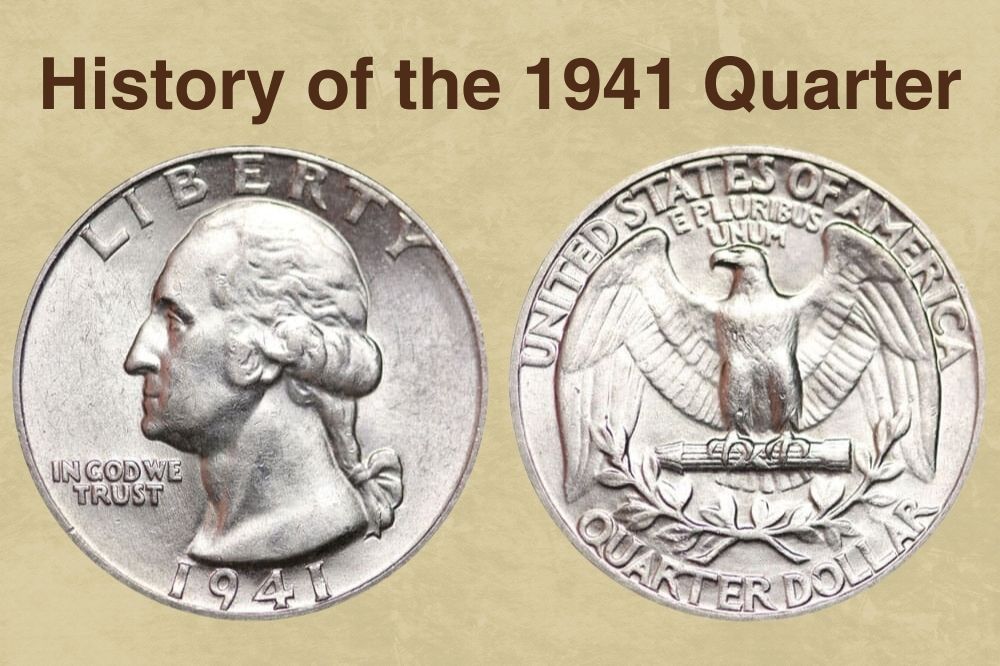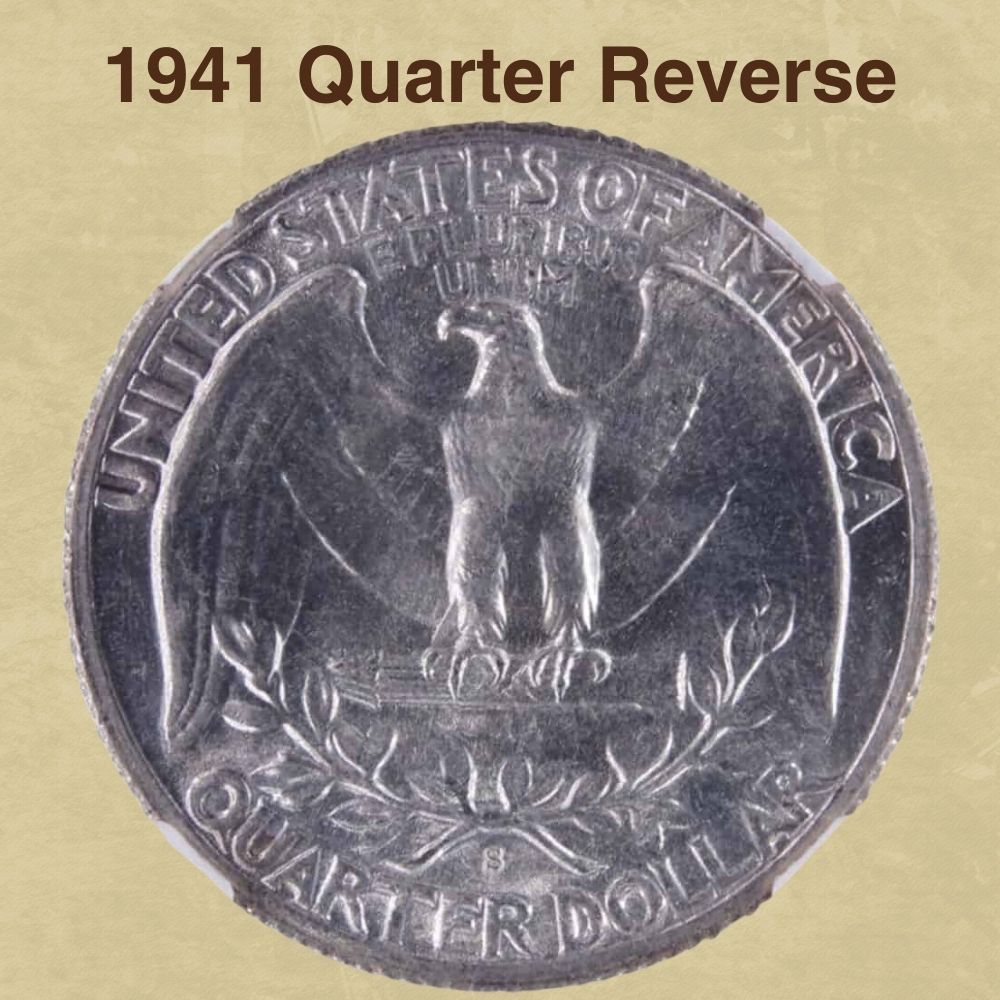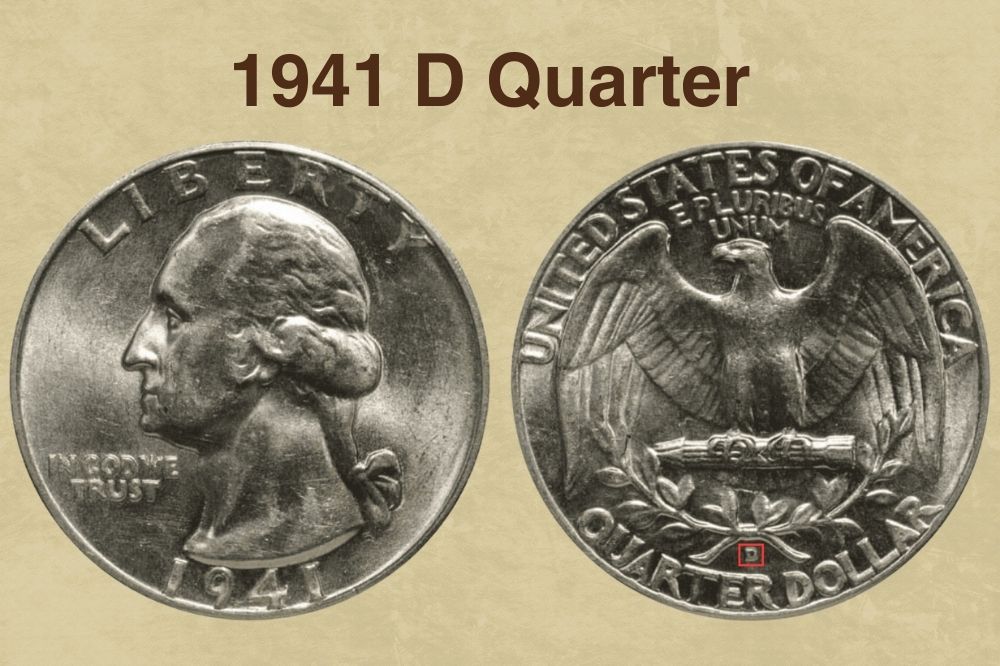
Coin Value Contents Table
The quarter issued in 1941 is one of the series known as Washington quarters. But is it valuable? That’s what we’re here to find out!
We’re going to look at the factors that influence the 1941 quarter value. We’ll find out how much difference condition makes to value. And we’ll discover that Mint errors can lead to coins that are highly sought after by collectors.
So if you’re ready to find out more, let’s get started!
1941 Quarter Value Chart |
||||
| Mintmark | XF45 | MS60 | MS65 | MS67 |
| 1941 (P) No Mint Mark Quarter Value | $8 | $12 | $45 | $285 |
| 1941 D Quarter Value | $8 | $28 | $75 | $650 |
| 1941 S Quarter Value | $12 | $36 | $65 | $450 |
| PR60 | PR65 | PR67 | PR68 | |
| 1941 (P) No Mint Mark Proof Quarter Value | $50 | $115 | $325 | $6,500 |
History of the 1941 Quarter
The quarter struck in 1941 will look familiar to anyone who’s used modern US currency. The portrait of Washington that appears on the obverse is essentially the same as that used until recent years. But while modern quarters are clad in cupronickel, the coins from 1941 were silver.
They’re part of the series known as Washington quarters, and the first of those were struck in 1932. The year marked the bicentenary of the birth of the first president of the USA, George Washington.
As the anniversary approached, preparations were made to celebrate the date in style. A bicentenary committee was set up, and amongst their projects was a special edition coin.
But it was eventually decided that a coin honoring Washington should be a permanent addition to the nation’s coinage, rather than a one-off. That meant that the decision on its design passed to the Treasury.
The committee had already chosen a portrait of Washington for the heads side of the coin. They had selected an image by Laura Gardin Fraser. But the Treasury Secretary, Andrew Mellon, preferred a portrait by another artist, John Flanagan.
The disagreement has been the subject of much discussion over the years. But it was Flanagan’s portrait that won out at the time. And it wasn’t until 2022, with the launch of the series known as the American Women quarters, that Fraser’s obverse finally got its turn.
1941 saw large volumes of Washington quarters struck at the Philadelphia Mint facility. The total was over 79 million, more than twice as many as any previous year.
The San Francisco and Denver facilities struck quarters that year too. And the Philadelphia facility also produced a small number of proof coins.
Also read: Top 13 Most Valuable State Quarters Worth Money
Features of the 1941 Quarter
The Obverse of the 1941 Quarter
The obverse (or “heads” side) of the 1941 quarter is what gives it the nickname of “Washington quarter”. It shows a bust of the first US president, depicted in profile and facing to the left as the coin is viewed.
The Treasury had held a competition for the design of the coin. It had stipulated that the portrait of Washington should be based on a sculpture of the President by the French artist Jean-Antoine Houdon.
Houdon’s bust had been made using a plaster of Paris mask of Washington’s face, taken during the President’s lifetime.
The initials “JF” for John Flanagan, the artist who submitted the winning design, appear at the bottom of the bust. The word “LIBERTY” arches above it. And the familiar motto “IN GOD WE TRUST” is inscribed to the left, just below Washington’s chin.
The Reverse of the 1941 Quarter
The quarter struck in 1941 has the same design on the reverse as every other Washington quarter until 1998. It too was the work of John Flanagan.
It shows a stylized eagle, symbol of the USA, its wings outstretched in a heraldic pose. The bird is perched on a bundle of arrows, and takes up almost the whole of the coin surface.
All the text is inscribed parallel to the rim of the coin. The country name, written in full as “UNITED STATES OF AMERICA” follows the upper coin edge.
Immediately below it, and above the eagle’s head, is the Latin motto “E PLURIBUS UNUM”. The words mean “From the many, one”, and they refer to the country’s birth from a union of the states.
Below the eagle is a second image, a sprig of olive tied in the middle with a ribbon. Like the text, it curves parallel to the coin edge.
And at the bottom, following the line of the lower coin edge, is the denomination, “QUARTER DOLLAR”.
In later years, the mint mark on Washington quarters was moved to the obverse. But if you have a 1941 quarter, any mint mark will be on the reverse. Look for it beneath ribbon on the olive branch.
A “D” signifies Denver and an “S” San Francisco. And if there’s no letter, your coin was struck in Philadelphia, which didn’t use mint marks in 1941.
Other Features of the 1941 Quarter
The quarter struck in 1941 has the same dimensions as the rest of the Washington quarter series. It measures 24.3 millimeters in diameter.
It’s made of 90 per cent silver and ten per cent copper. That composition makes it slightly heavier than modern quarters, which are copper with a cupronickel cladding. It weighs in at 6.30 grams, compared to 5.67 grams for modern coins.
It has what’s known as a reeded edge, a series of grooves around the edge that run parallel to the coin faces. This design was first introduced in the eighteenth century, as a way of telling whether precious metal had been clipped from the coin edge.
The text on 1941 quarters isn’t quite as clear as that of coins minted later in the series. The dies were changed in 1944 to give a sharper finish and to slightly enlarge the date.
This YouTube video from BigDCoins looks at a number of 1941 quarters with various levels of wear.
1941 Quarter Grading
| # | Grade |
|---|---|
| 1 | Basal State-1 |
| 2 | Fair |
| 3 | Very Fair |
| 4, 5, 6 | Good |
| 7, 8, 10 | Very Good |
| 12, 15 | Fine |
| 20, 30 | Very Fine |
| 40 | Extremely Fine |
| 50 | About Uncirculated |
| 60 | Mint State |
| 65 | Mint State |
| 70 | Mint State |
Please check our grading guides to know your coin scale, It’s the necessary step to know the exact value of your coin.
Check out now: How to Grade Washington Quarter?
1941 Quarter Value Guides
1941 No Mint mark Quarter Value
The Philadelphia Mint struck almost 80 million quarters in 1941. That was more than twice the number of Washington quarters it had ever previously produced in a single year. And the independent coin graders, the PCGS, estimate that around 7.9 million of them survive today.
A 1941 Philadelphia quarter in poorer condition, then, is pretty easy to find. And that means that values are modest. Uncirculated coins are rarer, but it appears that many of those were saved carefully at the time. That means it’s not too difficult to find a coin in excellent condition.
And it’s condition that’s key to the value of an individual coin. Coins are graded on a scale from 1 to 70, with 1 being the poorest and 70 the best.
A 1941 Philadelphia quarter graded XF45 (the letters stand for “extremely fine”) is valued by the PCGS at $8.
If you’re looking for an uncirculated coin, an MS60 example (“mint state”) is worth around $12. And at MS65, the lowest level at which a coin is considered a “gem”, the value is around $45.
The finest known 1941 Philadelphia is a single coin graded MS68+. There’s no public sales data for that one, and the PCGS doesn’t hazard a guess at its value. But five coins have been certified at MS68, and those are each valued at an impressive $17,000.
1941 D Quarter Value
The Denver Mint facility struck 16.7 million quarters in 1941, marginally more than the San Francisco facility. Today, around one in ten of those survive in all grades. In mint condition, the number is estimated to be around 20,000. And if you want a gem, the pool is just 8,240 coins.
In circulated grades, values are similar to the Philadelphia quarters of the same year. An extremely fine (XF45) coin is worth around $9.
In mint state, however, 1941 Denver quarters are somewhat rarer than their Philadelphia equivalents. A coin graded MS60 will be worth around $28, more than twice the value of a Philly quarter at the same grade.
At MS65, the value rises to $75, and climbs steeply to $650 at MS67. The finest known examples are four coins graded MS68, and those are valued at $13,500 apiece.
1941 S Quarter Value
The San Francisco Mint facility struck a shade over 16 million 1941 quarters. Around ten per cent are believed to survive, with roughly 22,700 in mint state.
Gem coins are fairly scarce, with similar numbers to other San Francisco quarter mintages of the early 1940s. The PCGS estimates the number of survivors at just over 8,000.
In circulated grades, the “S” mint mark carries a small premium over Philadelphia and Denver quarters. An XF45 example is valued at $12, around 50 per cent more than the equivalents from the other facilities.
In lower uncirculated grades, however, values are similar for all mint marks. A 1941-S quarter is worth around $36 at MS60 and $65 at M65.
The major jump in values comes at MS67+. While over 100 coins have been graded at MS67, only 28 have been certified MS67+. The value accordingly leaps from $450 to $2,500.
And the finest 1941-S quarter out there is a single coin graded MS68. That last sold in auction in August 2022 for $30,000.
1941 (P) Proof Quarter Value
As well as producing regular quarters in 1941, the Philadelphia Mint facility also produced proof coins. These were made using highly polished planchets and specially prepared dies, and they were aimed at collectors.
Just 15,287 proof quarters were struck in 1941. But despite their high quality and low numbers, they are still relatively affordable. That’s because almost all of them – around 12,000 – are believed to survive. And most of those are in excellent condition.
The lowest available grade is AU50 (“about uncirculated”), and a coin at that level is valued at $28. The value increases to $50 for a mint state example at MS60, and a gem MS65 is worth around $115.
The PCGS has graded one coin at MS68+, but that’s never been sold publicly. An example certified at the same grade by rival agency the NGC sold at auction in 2020 for $3,120.
Also read: Top 16 Most Valuable Modern Quarters Worth Money
Rare 1941 Quarter Errors List
1941 (P) No Mint Mark Double Die Obverse
Some of the 1941 Philadelphia quarters have what’s known as a double die obverse. That’s an error that results from the die used for the obverse design moving during the hubbing process. As a result, parts of the design are doubled. That error is then transferred to the coins struck by the die.
The value of the error coin will depend on its condition. An example in a low grade like 4 or 6 will be worth $8 to $10. At XF45, the figure increases to $25. And mint state coins start at around $44.
The finest examples of this error to have been discovered to date are graded MS67. One such coin, certified by the NGC, sold at auction in August 2022 for just over $500.
1941 D Double Die Reverse
Double die errors can occur on either side of coins. And some of the 1941 Denver quarters were struck with a reverse die that had doubling.
You’ll probably need a microscope or loupe to spot it. It’s easiest to identify it on the lettering, particularly in the country name.
As ever, the value of an individual coin depends on its condition. A quarter with this error graded AU50 is worth around $100, rising to $150 at MS63, and $250 at MS65.
This YouTube video from Treasure Town looks at these and other errors amongst quarters dated 1940 to 1943.
Also read: 17 Most Valuable Quarter Errors Worth Money
Where to Sell Your 1941 Quarter ?
Now that you know the value of your coins, do you know where to sell those coins online easily? Don’t worry, I’ve compiled a list of these sites, including their introduction, pros, and cons.
Check out now: Best Places To Sell Coins Online (Pros & Cons)
FAQs
How much is a 1941 quarter worth today?
Answering that question depends on several factors. The mint mark of the coin, whether it has a Mint error, and above all, condition, will determine its value.
The better the condition of the coin, the more valuable it will be. In poorer condition, coins with an “S” mint mark are worth a little more than those with a “D” or no mint mark. But the value will only be a few dollars.
Best in class examples with any mint mark, however, can be worth thousands of dollars.
Is a 1941 quarter made of silver?
Yes. The quarters struck in 1941 are made of 90 per cent silver and 10 per cent copper. Their composition changed in 1965. Since then, quarters have had a copper core, clad in an alloy of 75 per cent copper and 25 per cent silver.














